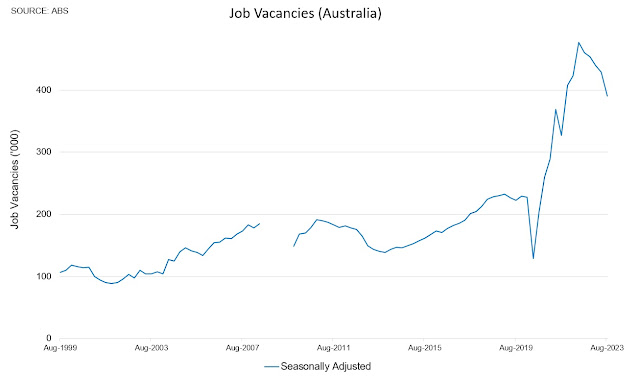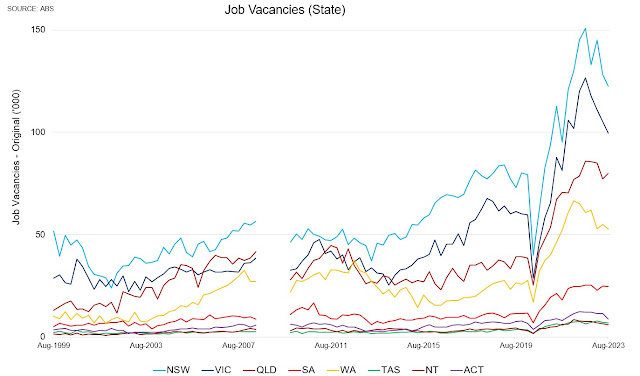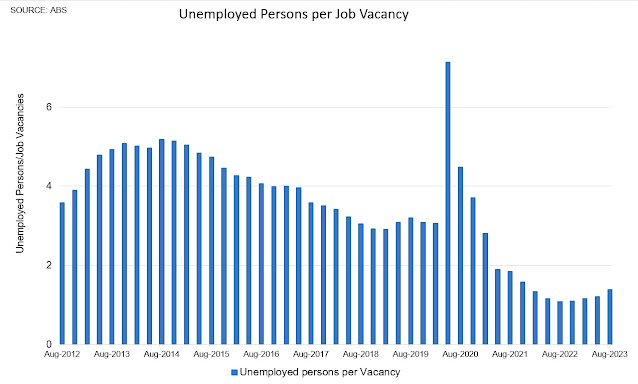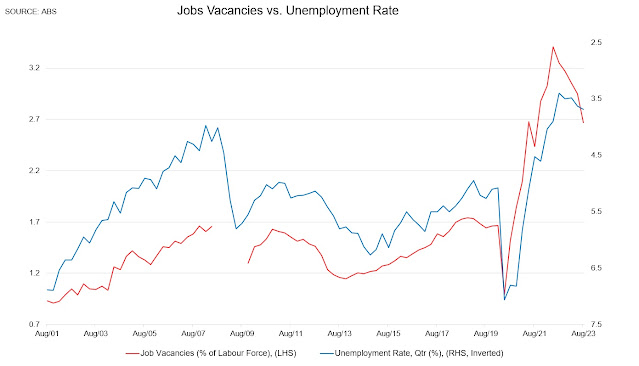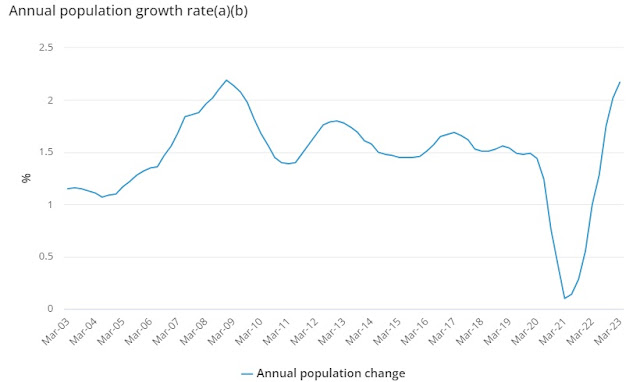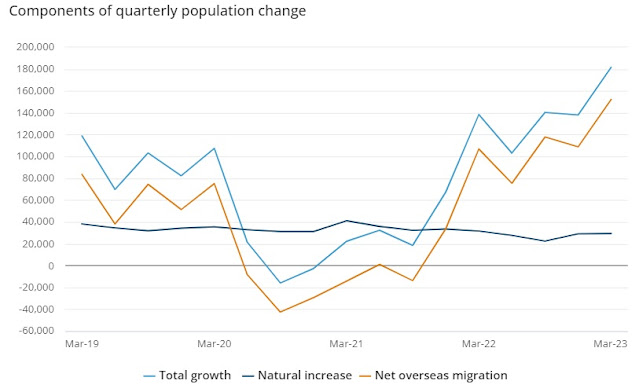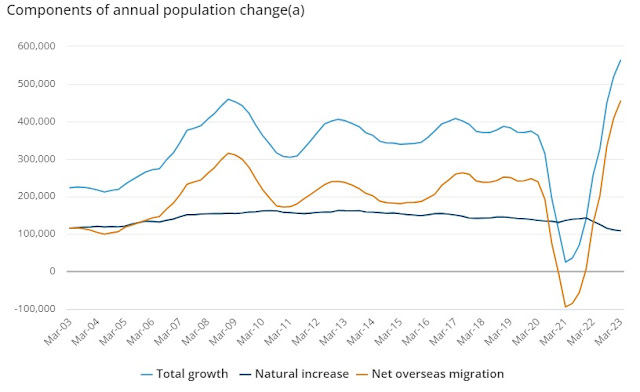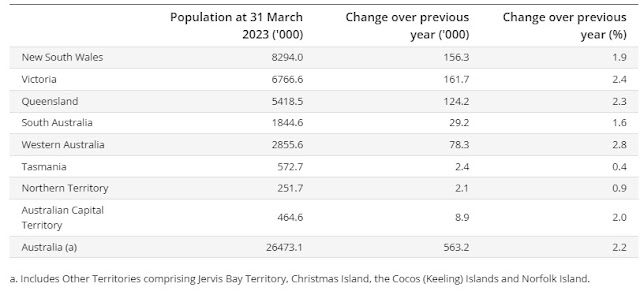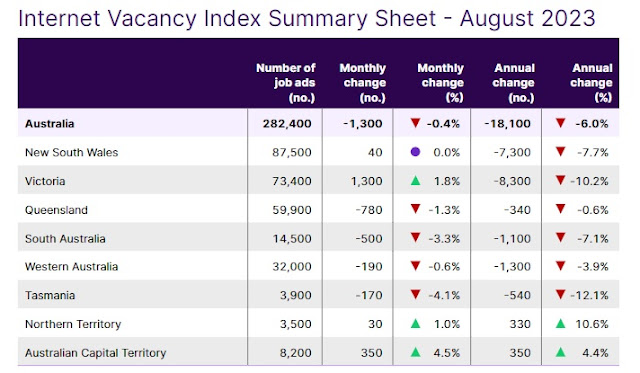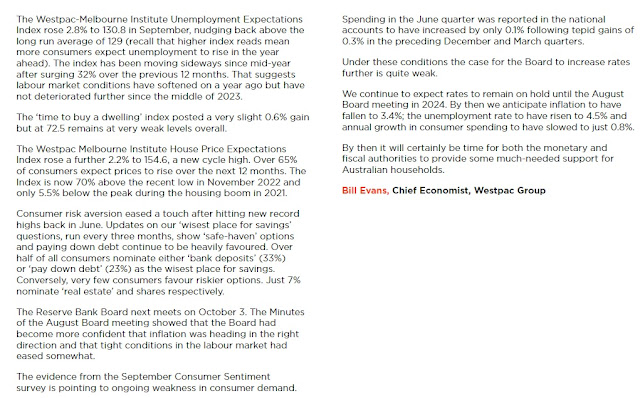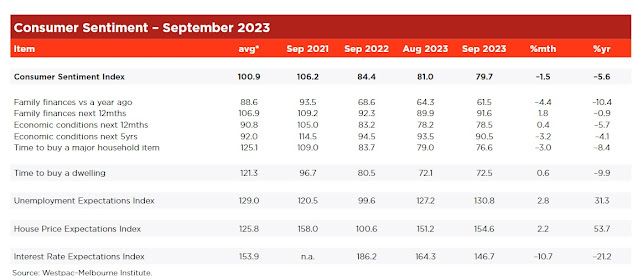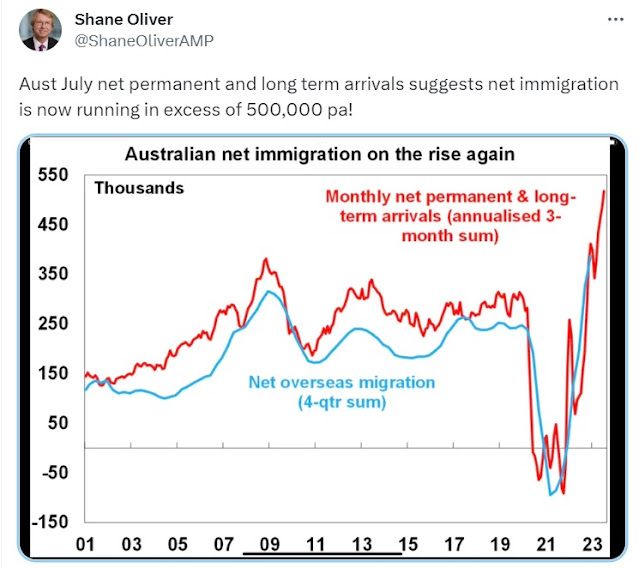Pete Wargent blogspot
PERSONAL/BUSINESS COACH | PROPERTY BUYER | ANALYST
'Must-read, must-follow, one of the best analysts in Australia' - Stephen Koukoulas, ex-Senior Economics Adviser to Prime Minister Gillard.
'One of Australia's brightest financial minds, must-follow for accurate & in-depth analysis' - David Scutt, Markets & Economics Editor, Sydney Morning Herald.
'I've been investing 40 years & still learn new concepts from Pete; one of the best commentators...and not just a theorist!' - Michael Yardney, Amazon #1 bestseller.
Friday 29 September 2023
Housing credit impulse turning...
Impulse turning
Credit growth came in at 0.4 per cent for August, and 5.1 per cent over the year.
Housing credit growth was steady at 0.3 per cent, again, as it has been of late.
Over the year, housing credit growth was 4.3 per cent (well below the 7.6 per cent seen this time last year).
Over the year total credit growth in the economy continued to decelerate, now down to 5.1 per cent, having been as high as 8.6 per cent a year ago.
Investor credit in the housing market has been anemic for the past year, once again recording net growth of only 0.2 per cent in August.
At a time of record high population growth, this means more chronic pressure on rental markets.
Eventually lending standards will need to be relaxed to get investment and construction happening again, but this probably won't happen until 2024 when inflation is definitively under control.
The housing credit impulse is gradually turning positive, but in fact housing prices have recovered much more quickly that might've reasonably been expected, due to record high population growth and very low stock listings.
Overall, this was pretty much as expected, with higher interest rates doing their thing.
Thursday 28 September 2023
Job vacancies plunge to earth
Job vacancies falling
Job vacancies dropped another 9 per cent over the 3 months to August, to be 18 per cent below their highs at 390,000.
Job vacancies were up over the quarter in Queensland, but are now dropping away sharply in New South Wales and Victoria.
The number of unemployed persons per job vacancy bottomed out at 1 in August 2022, but has now increased to 1.4...so things are normalising quite quickly now.
In fact as the labour force expands quickly the unemployment rate is already heading to 4½ per cent, and possibly higher in due course.
Retail turnover also continued in a very weak trend, ensuring that the Reserve Bank will keep interest rates on hold to allow the tightening still in the system to work its way through for a bit longer.
Wednesday 27 September 2023
Monthly inflation...still heading the right way (fuel aside)
Fuel drives inflation rebound
As expected by markets, the monthly inflation indicator came in at 5.2 per cent for the year to August.
This was an increase from the very sharp drop to 4.9 per cent last month, but below the 5.4 per cent recorded in June.
The increase was mainly driven by rising fuel prices, driven more so by global forces, and rents, which are being pushed higher by record immigration and tight lending conditions.
Excluding volatile items - fuel, fruit and veg, and holiday travel - the indicator rose 5.5 per cent in August, down from 5.9 per cent in July.
Since this was in line with market expectations, the Aussie dollar and bond markets were largely unchanged.
Things are gradually moving in the right direction, but still a drop in fuel prices would be most welcome!
Immigration set to slow
Population growth to calm down
We're in the eye of the storm for record population growth at the moment.
But much of the surge has been driven by the rebound in temporary visa holders, and things will calm down again soon enough.
I discussed this with Danielle Ecuyer on ausbiz TV here (or click on the image below):
Tuesday 26 September 2023
Monthly CPI to creep back up
Inflation to rebound in August
Been travelling around a bit over the past fortnight - hence the lower blog post output - speaking at events in Port Macquarie, Newcastle, and Sydney.
Next stop is Victoria for the next week (it's also Grand Final weekend), but there's still time to join the Rask Roadshow Sydney event, which is now close to selling out.
Get your tickets here.
It's been a rather slow news week, but tomorrow the ABS releases the August figures for monthly inflation.
This is likely to show a rebound from last month's sharp drop, driven by fuel, insurance, and some other services costs.
In other news, home values continue to recover and rise solidly according to CoreLogic's index:
Source: CoreLogic
CoreLogic wrote this week about the NHFIC forecast of a dwelling deficit of 175,000 by 2027, particularly in the unit market, driven by above average population growth and below average dwelling completions.
As interest rates begin to fall, the vacuum in unit supply is expected to fuel a stronger price boom in the more affordable unit market over the next 3 years.
You can the article here.
KPMG also released its latest forecasts, predicting solid dwelling price growth for all capital cities ahead through 2024 and 2025.
Population growth is increasingly becoming a political issue, but is likely to naturally slow over the period ahead.
The massive rebound in population growth has largely been driven by the return of international students and a record 2.55 million people in Australia on temporary visas.
Looking ahead, I expect to see population growth easing back to under 400,000 per annum, or a more sustainable 1½ per cent per annum.
---
The ASX 200 opens at 7,040 this morning, a little below the level seen in February 2020.
It's been a wild ride to hell and back since then!
Sunday 24 September 2023
2-Sense: Rents to slow, even as population booms
2-Sense
This week on the podcast, Batesy and I discussed population growth hitting 2,000 per day.
Nevertheless, rents are expected to slow.
Tune in here (or click on the image below):
You can also watch the video version at YouTube here:
Saturday 23 September 2023
Navigating Australia’s Land Cycle: A Conversation with Pete Wargent
Land cycle
I joined Catherine Cashmore at Fat Tail Research for a longform discussion to chat about the latest property market dynamics, the land cycle, and more.
Tune in here (or click on the image below):
You can also watch at YouTube here:
Thursday 21 September 2023
Home prices higher over the year (PropTrack)
Home prices move higher
Capital city home prices increased by 0.35 per cent in August according to PropTrack, to be 3.4 per cent higher than a year earlier.
Despite many doom and gloom forecasts, the market has been surprisingly resilient in the face of a large and rapid increase in interest rates.
Prices are slightly lower than a year earlier in Hobart (-4 per cent), Darwin (-1 per cent), and some parts of regional Australia.
Overall, thought, it's been a case of onwards and upwards for the capital city markets, with the next move in interest rates likely to be down, in the face of a massive dwelling shortage.
Melbourne's office attendance more than halved
Office woes
Been a bit quiet on the blog this week as I've been presenting at a few regional events, in Port Macquarie, Newcastle...and on this Friday in the afternoon I'll be presenting at Circular Quay in Sydney with Chris Bates from Blusk (please email me if you want a ticket).
The Reserve Bank of Australia released its September Bulletin, which had some interesting insights as usual.
Notably, in the commercial property space, Melbourne's office attendance as at February 2023 was still below half of the levels seen pre-pandemic.
Presumably this will have improved over the past 7 months, but still it's an alarming drop.
Sydney's recovery is faring somewhat better, with occupancy up to around two-thirds of the pre-pandemic level by February this year.
Source: Reserve Bank of Australia
Office vacancy rates in Australia are tracking at around 15 per cent, which is the highest figure reported since the early 1990s recession, although commercial bank exposures in Australia are reportedly relatively low in global terms this time around.
Office rents have naturally fallen from their pre-pandemic highs, although they have now stabilised and may even be rising a little, while Aussie office asset values have dropped by close to 10 per cent (though not as much as in other countries, such as the 20 per cent declines seen in Europe).
Wages growth peaks
In another interesting section was a consideration of the slowdown in wages growth.
Official ABS measures of wages growth have reported surprisingly tepid increases in wages, all things considered.
RBA liaison considers a range of more timely measures of wages growth, ranging from business surveys to enterprise agreements, and other private sector measures.
The numbers vary, but overall the most timely measures seem to suggest that wages growth is peaking and rolling over.
Source: RBA
This makes sense given record immigration and the slowing economy.
State budgets this week revealed many grand plans for building more housing, but the underlying issues remain.
While population growth is now running at a record high of around 650,000 per annum, new housing starts have slumped to decade lows, falling by 23 per cent according to the latest Housing Industry Association survey of Australia's largest 100 homebuilders.
The Victorian state government is introducing yet another slug to landlords, this time in the shape of a 7.5 per cent levy on short-stay rental income.
Meanwhile lending settings remain exceptionally tight, making life extremely difficult for first homebuyers and prospective landlords (in fact, more landlords are selling, exacerbating the rental crisis).
Tuesday 19 September 2023
Inflation expectations ease to 19-month low (ANZ cuts rates)
Inflation expectations drop
The interest rate hikes are working their magic
2-year inflation expectations fell to the lowest level since February 2022, according to the latest ANZ-Roy Morgan survey.
This sort of reading is consistent with inflation returning to the target range.
Good news, even in the face of a recent rise in fuel prices.
Crucially, rising fuel prices should now lead to lower consumption (unlike during the pandemic when the stimulus cheques were flying around and household savings rates were at very high levels).
---
ANZ cut its 3-year fixed mortgage rates by 30 basis points this week.
Source: ANZ, broker channels
H/t Eric Wu, broker channels.
Sunday 17 September 2023
Property Masterclass live (Sydney)
Property Masterclass
This week I'll be hosting a live event in Sydney.
Pick up your free ticket here (or click on the image below):
2-Sense: Business insolvencies at 15-year highs, office towers take a hit & population surge
2-Sense
This weekend on the Australian Property Podcast, Chris Bates and I discussed the big 3 property news stories of the week.
Tune in here (or click on the image below):
You can also watch the video version here:
Thursday 14 September 2023
Population up by a record +182,000 in Q1
Population balloons
Australia's estimated resident population increased by a record +181,600 or +0.7 per cent in the March quarter.
The annual growth increased to +563,200 or +2.2 per cent, and it's now certain that we'll see record high annual figures recorded over the next six months.
Source: ABS
Net migration accounted for +152,000 of the quarterly increase, with around +30,000 accounted for my natural population increase (births minus deaths).
Source: ABS
Over the year population growth of +563,000 is a record high, with this figure set to soar to around +650,000 or more as the year progresses.
Over the year to March there has already been thumping population growth in New South Wales (+156,300), Victoria (+161,700), and Queensland (+124,000).
The fastest rate of population growth was recorded in Western Australia +2.8 per cent).
Source: ABS
The economy would need to create +35,000 jobs per month to absorb this rate of population growth, which won't be possible, and clearly housing supply won't be able to keep up either, underpinning the property market.
Similar trends are playing out in New Zealand and Canada, it appears.
The population today sits at around 26,775,000, which is about where we'd have got to with no pandemic.
Source: ABS
An extraordinary rebound.
Slack increases in labour market
Part-time jobs rebound
There were some potential seasonality issues in last month's jobs figures, meaning that we were always likely to get a bit of a catch-up this month, as I noted on the Twitter early this morning.
And indeed, employment increased +64,900 in August, although it was almost all part-time work in nature.
After accounting for revisions, total employment was around +75,000 than reported last month at a record high 14.1 million.
Population growth is running at an unprecedented rate, but this solid trend in employment growth was enough to hold the unemployment rate at 3.7 per cent, for now at least.
Despite this, slack in the labour force is clearly now increasing.
The underemployment rate has increased from just 5.8 per cent in February to 6.2 per cent, while the underutilisation rate is now 10.2 per cent, having fallen as low as 9.3 per cent in October 2022.
This is a Goldilocks result, with the rising rate of underutilisation pointing to slower wages growth ahead, and no further requirement for interest rate hikes.
James Foster ran through the detailed figures here.
Wednesday 13 September 2023
Jobs ads easing (immigration at all-time high)
Job ads easing
Job ads decreased by -0.4 per cent in August (or ads), to be -6 per cent lower than a year earlier.
Although job ads remain at a historically strong level for the time being, a range of forward-looking indicators are now pointing towards the unemployment rising towards 4½ per cent over the months ahead.
Source: Jobs and Skills Australia
The easing in conditions has largely been a capital city phenomenon, driven mainly by Melbourne and Sydney.
All of this is further consistent with the interest rate cycle having peaked, with rate cuts likely to follow in 2024, as articulated by Bill Evans of Westpac:
Source: Westpac
Westpac's latest consumer sentiment figures showed a renewed decline in sentiment, but interest rate expectations easing and house price expectations continuing to rise.
Source: Westpac
Tight lending settings and the related housing shortage are likely to be a key factor here.
Developers have poured scorn on the idea that Australia will be able to supply the promised 1.2 million dwellings over 5 years, suggesting that a net addition of 120,000 new homes each year might be a more realistic level, if we're lucky.
This week's arrivals and departures figures confirmed ongoing strength in net long-term and permanent arrivals at a much higher level than previously expected.
Shane Oliver from AMP charted the surge:
Big numbers.
Subscribe to:
Posts (Atom)





